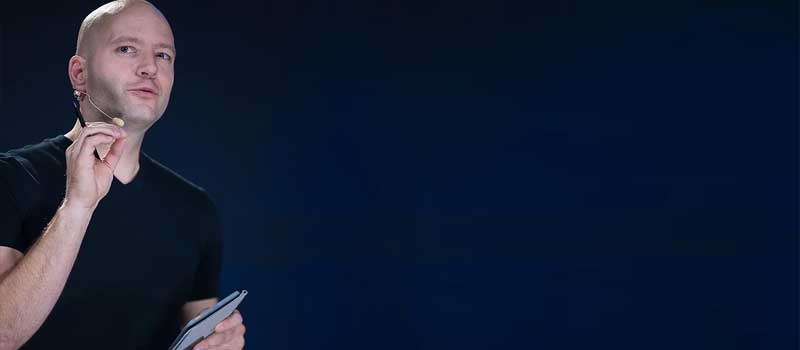Mr. Mark. Drager Founder and Director of Phanta Media, speaker, and host of the super successful podcast, We Do Hard Things.
He’s interviewed the likes of YouTube sensation. Evan Carmichael, legendary motivational speaker, Les Brown, and SEO master Rand Fishkin to name a few.
Over 15 years of agency experience and cut his teeth in the agency world back in 2005. Thrown in at the deep end with a full-service marketing firm before then going on to build his multiple seven-figure agencies, working with clients from startups to household name brands and multinational corporations.
In our chat today, we chew the fat on sales, marketing, and strategy processes of top running agencies.
So if you want to learn from a multiple seven-figure agency leader about how to position to attract better leads, how to convert those leads into clients, and the most potent strategy for organic agency growth and stick around for this article.
The Importance Of Strategy

Stephen Houraghan
Why don’t you give us a quick background of where you’ve come from, starting from getting into the creative industry right up until where you are today and what you’re doing now?

Mark Drager
A big part of it, I think like so many of our journeys is we start off with a tactical skill set.
I went to film school because in my mind originally I wanted to be an architect. I loved space. I love environment. I love light. I love materials.
I used to, as a kid draw floor plans in imagine eyelines and I build out of Lego and I would just, I was enamored with space and design and all of that stuff.
Then I got really scared and I thought being, becoming a civil engineer, becoming an architect, spending 12 years, doing that and the stress, and then can I do it.
I just got scared and I went to film school instead. Graduating film school I was lucky enough to work in television. I was lucky enough to work some freelance, but where I was luckiest was I landed a job at an internet marketing franchise in 2005.
I don’t know if people remember young listeners, what young people do you guys know that the internet in 2005 seemed pretty cool at the time, but YouTube wasn’t owned by Google.
We still had dial up, Broadband was just starting. MySpace was a thing because Facebook hadn’t yet been really launched.

I was responsible for producing all of the video content and all of the training and all of the marketing and all the materials for this franchise that had 1500 offices in 89 countries and territories.
It was like a crash course in business. I’m this film school guy who gets this job, cause like I can edit and I know Final cut pro and I could figure out Photoshop.
I got this job and I realize this is about storytelling. This is about communications. This is about educating. This is about retention, this is about understanding.
And so very quickly, because I was terrified of getting fired from this job. I covered my butt by asking a million questions. I would just;
What are you thinking internal client?
What does this project look like?
What do you think?
Who are we speaking to?
And what do they care about?
And just helped me understand everything.
So that way, when I give you what you’re asking for, if you’re like this, isn’t very good. I could at least say “I gave you what you want“.
Let’s go back to the beginning. That was day one for me, realizing that
More important than creative, more important than ideation, more important than anything else is strategy mixed with how people think and feel about what you’re doing.
Start With A Tactical Set

Stephen Houraghan
That’s what we live with and that’s, that is really the crux of the problems that we come to with clients when they decide that they want to build a brand and they’re having the opinions based on taste.
What they like, whether it’s naming their brand after their dog or their street, or it’s picking their brand colors because they like that, that’s their personality.
And this is why they’re are so many misconceptions and so much misunderstanding about what branding is.
And I guess that’s really where strategy comes into play. So when it, when it came to, so you’re doing all this work, right? And you’re, you’re creating all this content.
At what point did the conversation become a bad brand, as opposed to, I’ll just ask you a bunch of questions here, your answers. Here’s what you’re looking for.
At what point does brand come into it and then thinking strategically about making this brand a success?

Mark Drager
Great question. So, so 2005, 2006, I leave that company to start my agency, Phanta Media.
I started at the end of 2006 and I bring a lot of the thinking that I was taught. So even already, then we have split testing headlines on landing pages.
We were split testing offers as we like, again, I learned in, on day one pre-social media, internet marketing, and because I wanted to be an engineer and an architect and stuff, I loved the process.
And so I grabbed a bunch of this stuff again, out of fear, because I’m going to be super honest with you.
People who are non creatives think that I’m creative, creatives realized. I’m not that creative. And so when I went to film school, I looked at all these people who came up with all these brilliant, fresh ideas.
And I thought all I’m doing is just cherry-picking bits and pieces of other people’s good work.

Like, like I’m a synthesizer. I’m not someone who’s going to come up with something brand new.
I’m going to take the bits and pieces that I love mixed them together into something new.
And to answer your question of when it became brand, I start in 2006, the V we start focused on video production, right?
So I talked about tactical skillset, right?
You could be a designer. You could be, you can be in, in, in print, you can be in web. You can be in UX, you can be in anything you want, but you start with a tactical skillset.
And I think for certain number of us strategy, isn’t something that we even know about.
But it’s something that becomes a necessity because I believe there are certain people who are fine, who are comfortable just owning their craft.
There’s nothing wrong with that, but there are other people who go wait a minute I want to produce work that works.
PRO Brand Strategy BluePrint
Build Brands Like A Pro Brand Strategist

Brand Strategy Works BTS (Behind The Scene)

Stephen Houraghan
I think a lot of people kind of relate to that and I certainly relate to that.
I wasn’t the best creative in the world. I loved it. I really liked it but there were so many others that were better than me and I think it is that level of creative where they just want to hone their craft.
They do not want to understand what’s behind the scenes or the strategy behind it.
It’s really not a bad function for them and, but there are a large chunk of people who love design. They’re passionate about, they might even be great designers, but they have that other side.
They have the, the left and the right kind of working together.

Mark Drager
I would disagree just to jump in real quick, because I think what it is that once you realize that a lot of decision-making is made abstractly based on taste, and that starts to bother you.
If you’re the type of person who sat around a room and realized that the whole campaign, the whole look, the whole whatever is hanging on this.
The thing that just someone came up with or came out of the blue where there’s nothing to back It,
There’s no data to back it, there’s no insight to back it. There’s no reason for that thing to be the thing.
That’s what bothers me enough to get me into strategy and eventually brand strategy.
I think most people where realize that it’s just not enough to make stuff and hope it works. I don’t say that to disparage people again, who have a craft who focus on that one part of the craft.
But those of us who get into brand strategy realize that a whole lot of stuff behind the scenes is just kind of being made up along the way.
That makes me uncomfortable charging people that make me uncomfortable dedicating my heart and my energy and my team’s energy to stuff. that doesn’t have a better shot of working.
Like I want stuff to work. I want it to be effective. I want it to be efficient. I want to know that when you sit across from me, I say, if you do X, you will get Y like, that’s what I want.
And that is what got me into strategy
Explore Brand Strategy
Programs & Tools
Foundation On Strategy Process

Stephen Houraghan
I totally agree and I think there is a level back from those who are just honed in on the craft who want to bridge the gap to strategy, but don’t know how to do it.
That is a huge chunk and it’s a huge chunk of people that I speak on a regular basis.
They’re closing that gap and because there’s been a blind spot within branding for so long because marketing has been there for decades.
They’ve been teaching branding as this subset of marketing for so long, and branding has just been left quietly to grow into this overarching dominating discipline that governs marketing, that governance business.
It’s done that quietly, the education side of thing, hasn’t kept up with it for professionals, and entrepreneurs.
This gap in the middle where strategy is just this thing and we’ve got a lot of people out there believing that you get a purpose, vision, and mission and values statement, and you’re good to go that’s your strategy.
If you’re why then everybody will buy because we’ve all read those books or seen those Simon Sinek, Ted talks these are all important pieces of the puzzle
But they’re just small pieces and there are so many more out there that connect.
I totally agree, with what you’re saying from the point of view that you’re not comfortable that there is nothing hanging.
So that really comes back to what exactly is brand strategy and what makes a successful brand or what is the foundations for successful brands.
So talk to me a little bit about your processes in terms of how you see strategy in terms of how you see those foundations and that process?

Mark Drager
Yeah, it’s interesting.
You brought up Simon Sinek because he’s mentioned a lot of course, Start with why, it was a Ted talk in 2007.
I think that that’s hurt a lot of small businesses to be really honest with you, entrepreneurs, small businesses, anyone who’s not a large corporation because we have to remember that, that if you go through that book, all of the examples are mega-corporations.
You’re dealing with apple, you’re dealing with US Army, You’re dealing with Volkswagen. You’re dealing with these large corporations and they need some purpose, they need some WHY
If you’re an owner-operator, if you’re in touch with your team, with your product, with what you are doing and you’re dedicating your life to it, it hurts you.
It hurts you because for too long, people have led their brand positioning their unique selling proposition.
For most of their messaging they’ve led it for the 5, 10 years with their purpose and their why, and that’s cool.
But if we lack clarity, if we don’t understand, if we’re not just saying simple language in simple words, no one understands what you’re talking about.
Let’s say you’re a financial planner who works with people between 1 and $10 million who want to help avoid taxes. That is a very simple proposition. It doesn’t separate you from anyone else but it does.

If every other financial planners is busy saying like we are holistic multi-generational BS crap that no one understands and they’re not going to parse out.
We’ve had this pendulum swing both ways.
My strategy is based on like a no BS. Let’s really try to simplify things as much as possible
What I’ve really kind of gotten allergic to are the people who say, I know my voice, I know what I want to say, and I’m going to shout it and if you don’t like it, take a hike, If you do like it, listen up.
don’t like that approach. I don’t like that. This is me. I’m going to be me and I’m going to divide and you’re going to jump on board or you’re going to hate me.
What I’d much rather do is an approach in a human way,
If you are going to a wedding and you’re standing in a church and you’re there talking to your grandma, you’re going to show up looking a certain way, acting a certain way, saying certain things.
If you’re out at, at the stag for this wedding with a bunch of guys, you’re probably going to show up a different way, looking at different ways, saying different things.
You’re going to show up to the scenario, to this circumstance in the version of you that you need to show up as and so follow. This is our process.
Our process is one. We need to start with you.
So if you’re working with, if you’re an agency owner, you’re working with clients, you have to
Define who they are.
What, is their goal?
What is their goal?
What are their goals or priorities?
Most people are fuzzy on that. Get that specific.
What is, what is their voice?
What are their values?
What are their past experiences you can leverage?
Are they better than they think they are?
Are they actually worse than they think they are?
People fall on one side of the spec. How clear are they on their actual USPs? Do they actually understand who they’re going after?
Not from a general persona kind of way, but can you get specific?
So we spent a lot of time understanding who that leader, who that leadership team is, who the company is, and it needs to be defined based on people.
Because if fancy people like you and I, or other brand strategists come along and actually say, this is who you need to become, and it’s not true to them.
Then eight months, 10 months, two years from now, they’ve drifted away because you’re not there to hold the task.
You’re not there to hold them to this artificial version of them. So, so you need to make sure we understand who they are, so we stay true to them.
Positioning Relevance To Audience

Stephen Houraghan
When it comes to positioning relevance on past experiences and what you can bring to the table can often be where you find a true differentiator or how you can position yourself?
How do you go into, or what do you do to kind of peel back those layers to understand how relevant they can be to their particular audience?

Mark Drager
Well, you don’t know yet how relevant they could be their particular audience, because what I think you I’ve seen, it said that you take an inside out approach.
I think I’m more manipulative than that, which is to ask the question,
Who do you need to be?
So you mentioned that I have this podcast, We Do Hard Things.
I interviewed some remarkable people and when you start to get into the mindset side of things, so let’s put business aside, but you can start to get the mindset.
When I speak to a Navy Seal and I asked them how they were able to accomplish what they were accomplish, it comes through them consciously deciding who they need to become and then becoming that person.
So if you follow this train of logic, we know that on one side, there’s the, you, there’s the true version of you.
Now, how do we know how to connect with our audience?
Our audiences, tell us what they want, what they’re looking for and what they need, and in the overlap between what’s true to you and what your audience wants you to show up as that’s how you should show up.
So there’s a lot of game then and our process focuses on three core areas.

Second, is Data
Now let’s look at our audience and again, not just personas, not just interviewing people.
Let’s look at data. Let’s look at there’s all kinds of amazing tools you can use. Like Spark Toro is a great tool that I don’t know if you’re familiar with it, but Rand Fishkin’s from Ramaz his new company, Spark Toro.
Great for deep diving, there’s all of this audience insight that we can pull that we can grab and now we understand who our audiences.
Third step to that is to do competitive audits.
Now, not to look at what your competition is doing, but to look at what they’re not doing. If you’re true to you and you look at the overlap on the Venn diagram and listen nurse.
I may, moving my hands around, but think about three circles on a vendor.
One is you. One is your customer audience and the third are what your competition is not doing in that overlap.
You have a message or an approach that’s true to you. You’re saying, and showing up the way your audience wants you to, and you’re doing it in a way that your competition is not.
Now. I challenge you to tell me that that’s not going to make you stand out and be unique.
That is that’s my approach. That’s my process and it was developed not because I found it in a book and not because , huge companies may leverage it. I honestly don’t know.
I have learned this by producing hundreds and thousands of tactical projects and going, what didn’t work and what did work.
We’ve continually refined the process to. It’s not going to work for a long period.
If we don’t come at it, understanding who our audience wants or desires, and then we’re gonna miss the mark 8, 10 times out of 10.
If we’re not looking at the competition, we’re not actually standing out.
We’re not actually differentiating ourselves in a way that’s meaningful to anyone else.
So you have to do those three things.
Client Structure

Stephen Houraghan
So when you sit down with your clients talk to me about your process in terms of bringing them into the fall.
Do you do this through a workshop environment?
What’s the structure that you use is different for every client?
Talk to me about that side of things, bringing them in and collaborating with you?

Mark Drager
So when Phanta was at its highest, we were a little over 2 million annual revenue pretty consistently 24 full-time teams.
We would do somewhere between three and 400 projects a year. Some of them are very, very large national campaigns with the NBA and doing all kinds of huge creative.
Some of them very tiny training videos or product launch videos or things like that and the reason I share that is because video, like so many talented or so many skillsets, has commoditized.
When I started, it was this big, giant black hole of confusion. No one could compare apples to apples.
No one could compare quotes. Everyone’s approach was different and over the course of. I have to do this 15 years now, it is commoditized.
Everybody now knows somebody could do video.
You could shoot it on a phone. Like some of the stuff we can do today is amazing, but I share all that to say my process all along has always been to spend a tremendous amount of time upfront with prospects.
This strategy process that we developed before we turn into a brand strategy and started charging people for it, we would give for free, I would want to know I would go through a full analysis.

I would spend four or five, six meetings. I would give away 10, 20 hours with a free consulting.
I would do it for this because in my experience, people who are willing to give you time, this won’t work with people with no money, this won’t work with people who have no offer or have a lot of time because they’re willing to take all your stuff for free.
You never know percent. I’m talking about the busy entrepreneur, the CEO, I would go into meetings.
And again, I come from the kind of a corporate world, but I go into meetings where we would have nine C-suite people around a table for four hours.
So how much money that meeting is, costing them in salaries?
So if they are willing to come back time and time again, and answer my questions and get deeper and deeper and become more presumptive in the sales.
By the time we got to quote-unquote the proposal, it was literally a contract that just that, that, that had everything that we’ve already agreed to.
So I love for these types of projects, cause, I want to charge a pretty healthy amount. I want to give people an amazing experience and frankly, I don’t want to set people up for failure.
So I want to pre-qualify people I want to know upfront. If this is going to be a train wreck, if it’s going to be a mess,
if it’s going to turn into a 12 month engagement, if there’s no way we can be profitable, if their expectations are too high.
So I spend a lot of time asking people questions, what do you, again, like it almost mirrors the, like, what do you want to accomplish?
And I’m, and I’m trying to dig deep and I’m trying to figure out if I can make sense of what they’re talking about and if I can follow their business strategy, because the brand strategy has to follow business strategy,

if I can poke holes and if it makes sense, and if a few ideas come off the top of my head and I just say, Hey, what about this and this and this and they seem to get excited about it.
I want to know that engagement and relationship is there before we ever talk about the logistics.
Before I mentioned that have a workshop version that’s one day, or we have a two-day bootcamp, or if you want to do a full service, it takes eight weeks.
And through those eight weeks, here’s the roadmap. And then it costs X and like all of that stuff. Boring. Like, like that’s just, let’s get that. We don’t even have to talk about that stuff.
That doesn’t matter because truly if you want, and this is what we sell, you sell it. I sell it, we all sell it. All people want is credibility or money.
That’s all people want.
Positioning Process

Stephen Houraghan
So when, when you’ve got these, these C-suite execs are in the room, so we’re still in the prospecting phase here. Talk to me about you how to go into detail.
Talk to me a little bit about that funnel, that top of the fall, and the process of getting them into that position.
Then transitioning into the offer and moving into, they’re our client now let’s do this.

Mark Drager
I come from an agency where we’re pitching creative for campaigns and stuff like that. And so I brought some of these tools, anyone who, let’s say that you’re a graphic designer and you’re used to showing five, a mood board.
Mock-ups, let’s say as part of your process,
Think about the exciting parts that the prospect that in this meeting you are showing them some work.
You’re asking them what they like and what they don’t like. You’re trying to maybe evaluate a common dialogue, a visual term.
So that way you can get a sense of what they like or to want or whatever but that’s a gaging that’s fun.
So, because I come from pitching creative and pitching campaigns and pitching all of this stuff.
I pull some of that stuff out of the actual delivery process and bring it forward because honestly we can kind of mock-up stuff pretty quick that impresses people because they have such low expectations that just gets them excited.

So what we do is we get them, we get them talking is one we need to find out, do they know
What do they want?
Are they making sense?
Are they okay spending the right amount of money?
Are they okay giving us the right amount of focus and time?
That might take 1, 2, or 3 conversations. It might take five minutes. They might be on board.
The next step typically is I want to come back with them. I want to come back to them with something that gives them a reason to move forward with it.
So they, it just because I got them excited about it doesn’t mean they’re gonna pick me.
Now this is where we have to be very careful as we’re brand strategists, helping other people differentiate themselves in the market.
I always ask myself, why would they pick us? Why would they move ahead with this, all these questions right? and if I feel like I don’t have a very good answer, then I continue to work away at it until I know that I’m going to come back to them with something that gives them a good reason to say yes.
So either I’m going to come back to them with high-level concepts and just walk them though you don’t have to do any mock-ups or anything like that.
Maybe I’ll pull up what we call jumping-off points or inspiration points. I’ll find other people’s work and I’ll spend hours and hours researching other things.
So I can put some boards together to say, here are a few directions I could see us going.
Maybe I get them excited about visualizing what this new brand will mean for them. So I talked about credibility or sales.
Let’s focus on credibility. Imagine, imagine you’re having so much trouble with recruiting in this market. Imagine one year from now, not only do you have a new look, a new, feel, a brand that you’re actually proud of, that you’re not embarrassed about it.
Imagine it’s a year from now, and you’ve not only been able to increase your sales.
You’ve not only been able to impress the pants off of all of your friends because they look at you and go smoke.
This is your company, but recruitment is so much easier because you have more credibility. Your social media channels are growing.
Like whatever it is, again, tie it back to the things that matter to them.
But I spend a lot of time making sure that before I ask anyone to move forward with anything it’s something that they want to do.
When you do that, then the rest is like, when do you think you want to get started?
Converting Prospect To Client

Stephen Houraghan
So it’s quite a hands-on, sales, process, of course, within there you’re asking tons of questions and but you’re also helping them to visualize that future brand,
Because that is the sales aspect, because you’re tapping into that emotion, you’re tapping into that desire.
How much weight do you put on the value of that particular process, helping them to vision that successful brand in converting them from a prospect to a client?

Mark Drager
So if you have an eight-type personality or an entrepreneur, who’s like ready to go and they’re like, yeah, I’m ready to go.
Then you just go great. Send you the contract. In, many cases, Yeah but in many cases, and again, everybody charges different amounts.
Let’s say if you’re comfortable or you’re building your business off of a $500 logo, it’s probably going to be a different approach than pentagram who might sell a million-dollar logo.
So we have to understand that, like, it really depends on, who you’re targeting, and what they’re willing to pay for.
I would always rather work with fewer people, be much more involved, build much more trust and charge many more dollars.
That’s how I built my business and focus on volume and the reason for that is because if I can set up enough credibility in the first few meetings, or even the prospect to be able to onboard a new client, this is someone that I want to be able to help.
I want to know. I want to know that my agency, that my team, that Mark Drager helped them. Pursue their passion at all costs grow something better, and create something.
And maybe like, I just, I want to be a part of that and I don’t want them looking at me three months, six months later and going well, that was a waste of time and money.

So again, maybe fear is what makes me invest so much time to make sure it’s a good fit.
But then on top of that, it makes the process better because we’ve already established a lot of trust and credibility through, through the pre-sales process.
And then imagine this, now you spend a week, two weeks, four weeks, six weeks, whatever it takes, you spend a good amount of time establishing a relationship with the client.
You then spend eight weeks or 12 weeks leading them through a branding process that excites them. But it’s also intimate.
Three Things To Build A Successful Agency

Stephen Houraghan
So if you had to strip away all of that, if you had to take away all of what you’ve done up until this point, you can keep your experience.
You can keep what’s up here, but you take away everything. Let’s say, let’s say you had, to skip town.
You don’t want people to know who you are and you even have to change your name and you have to, I’m not suggesting that you’ve done anything too bad here, but let’s say you have to skip town and you have to start from the bottom.
What would be the first three things that you would do to build up a successful agency?

Tom Gilbert
Okay. so the first thing is always start with your consumer.
Really, really understand your consumer, what makes them tick and think quite personally as well, observe them, they would just rely on data.
Then once you’ve identified that.
Your role as a brand is then to connect with the opportunity to solve the problem, find a solution for that, for whatever they’re looking for.
But do it in a unique way that’s distinctive to you. So when we’re faced with that challenge with new clients or clients look into the history.
They found a story, the origin of the company, like find some unique stories that only you can talk about because that makes you distinctive.
If you’re going into a very competitive landscape, people will all be talking about the same thing as they’ve studied the consumer and they’ve found the same opportunities.
The only thing that can make you unique is by looking inward at your brand, your company, to find out what’s distinctive about your story and the way that you do things.
So we’ll do that for the brand story, but then when it comes to visually expressing it as we’ll make sure that we. We’ve got distinctive brand assets, um, that help you stand out within that marketplace.
So there’s a part of that second point is just to make sure that you’ve got all the key ingredients ready for.
The third point, will be, make sure you’re thinking holistically and that will heal and story across all the different channels that you’ll be communicating your brand within the south.
Third point is then making sure you’re thinking big about that consistency, but then be prepared to deep dive in and focus on details.
When you need to, to ensure you get a consistent quality throughout your brands.
Wanna Learn More About
Brand Strategy?
On-Demand Digital Program
Brand Master Secrets
Make the transition from hired-gun to highly valued brand strategist in less than 30 days. The systems, frameworks and tools inside this comprehensive program are all you need to level up.












